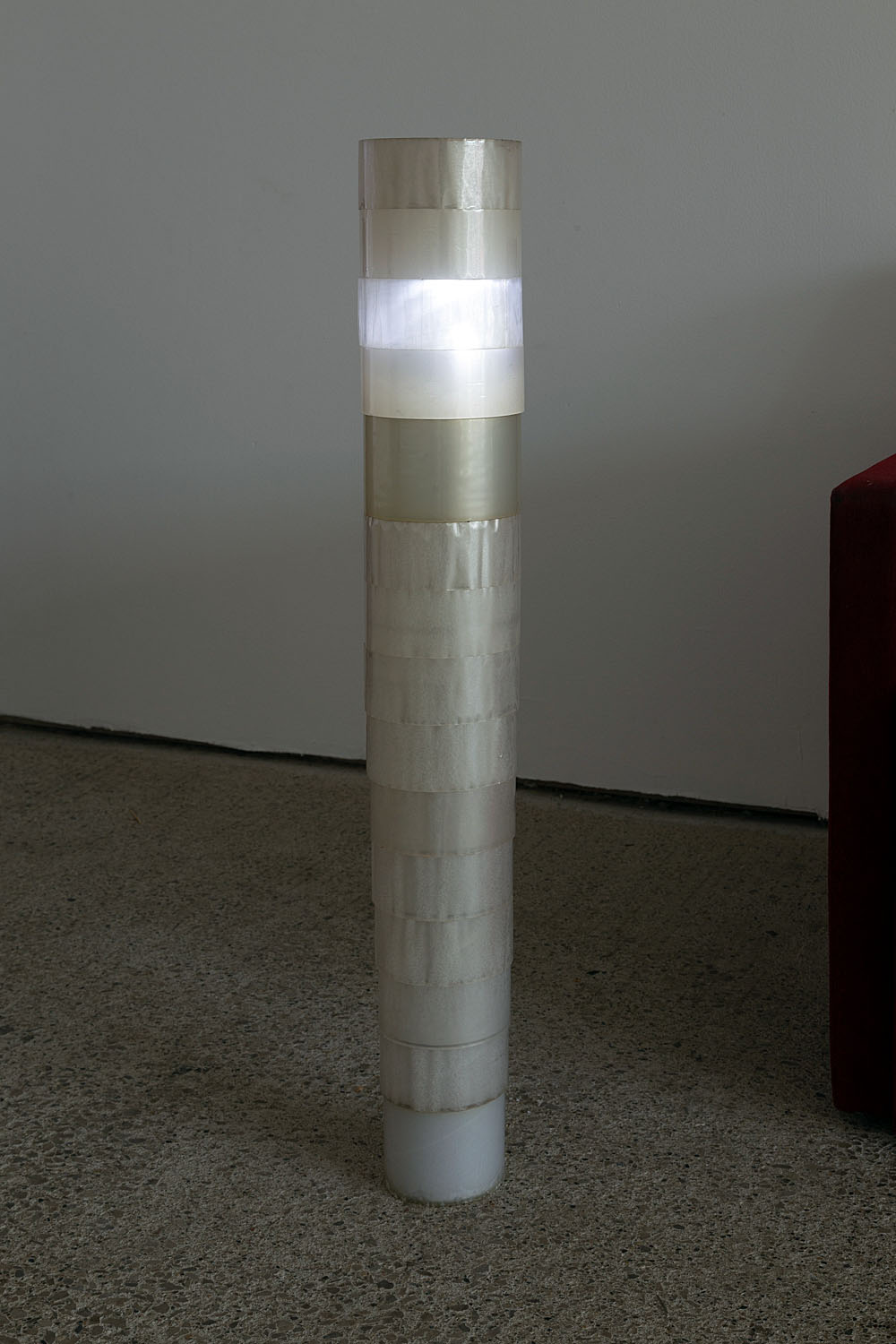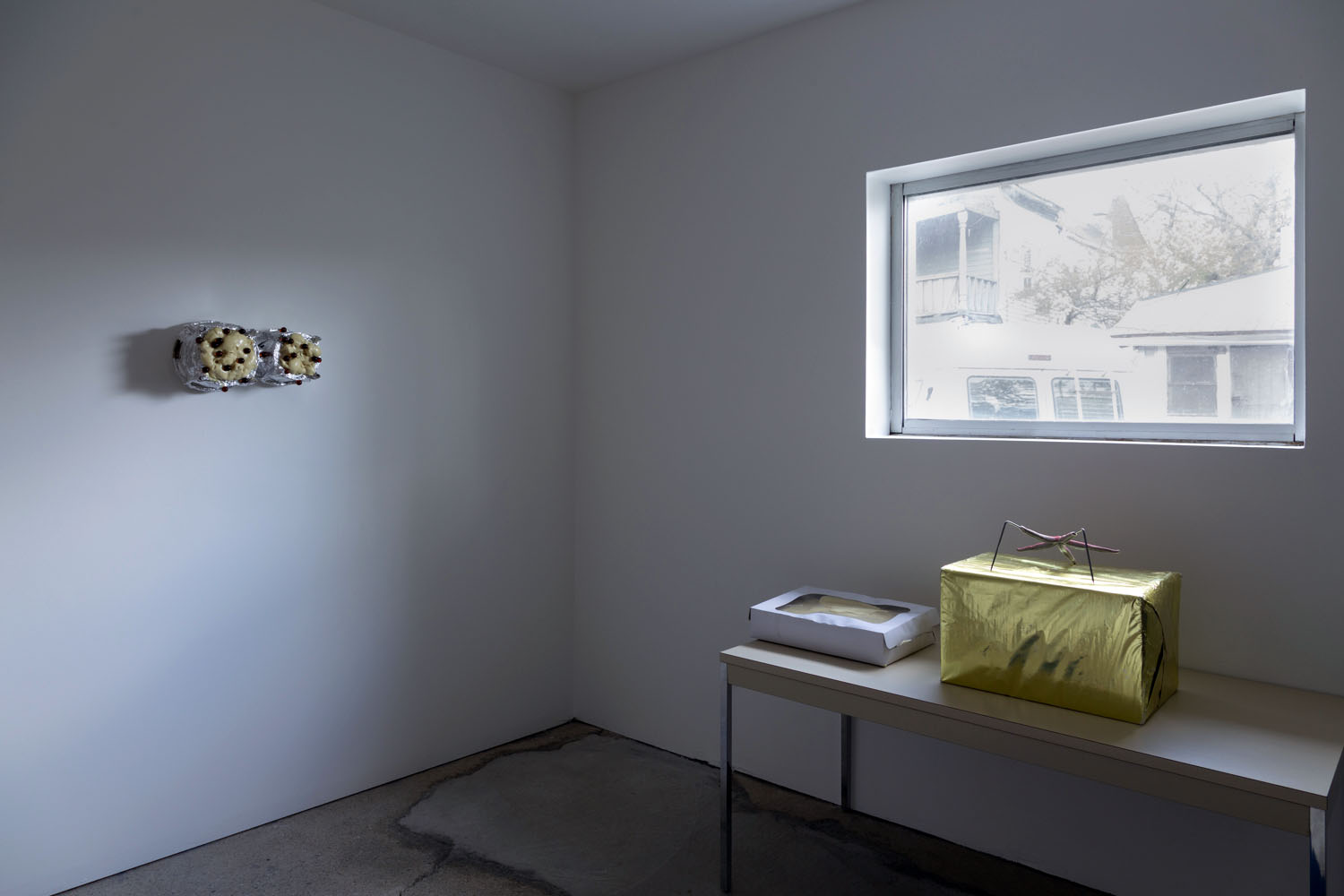
Michael E. Smith, Installation view: What Pipeline, 2024. Courtesy of the artist, Andrew Kreps Gallery, New York, and What Pipeline, Detroit. – Photos: Alivia Zivich
Entering the dimly lit, modestly scaled, rectangular space that features the Michael E. Smith exhibition at What Pipeline gallery, shy of a single object festooning the walls, a visitor might wonder where they have landed. Sparsely furnished with six red velvet armchairs (c. 1950s?) pushed flat against the walls and arranged asymmetrically around the space, they are conspicuously worn, discolored, and stained.

Michael E. Smith, Untitled, 2024, tape, plastic, LEDs, 4 x 4 x 29.5 in.
Providing dusky illumination via LEDs are three thin, tapered pedestals fabricated of stacked rolls of packing tape that also simulate ashtrays. Such accoutrement suggest an empty, forlorn gathering space or institutional waiting room, perhaps of a hospital, dormitory, sleazy hotel lobby, bus station, or brothel.

Michael E. Smith, Untitled, 2024, basketball, tape, metal rods, 9 x 9 x 16 in.
Soon, one notices an oddity, just 16 inches tall, positioned on the floor: a black orb supported on four slim metal rods that reads as a “character” (as described by Smith) with black taped head, metal arms and legs dwarfed by the furnishings surrounding its mute, frozen presence. Marooned in a world of Big Furniture, the diminutive character appears overwhelmed as it sizes up its location, situation, and intentions, perhaps the avatar of an artist evolving a project.
Sculptor and installationist Smith, born in Detroit in 1977, studied at College for Creative Studies and Yale University, exhibits nationally and internationally, as well as at Susanne Hilberry (since closed) and What Pipeline galleries in Detroit, and now lives and works in Providence, Rhode Island. A collector of objects (especially chairs), he transports a selection of found materials to exhibition venues and arranges and edits his miscellaneous trove on site preparatory to opening day.

Michael E. Smith, Installation view: Michael E. Smith, What Pipeline, 2024.
After traversing the spartan introductory gallery and proceeding into the adjacent gallery/office, enticing “treats” by Smith greet the exploratory visitor. Delectable objects on wall, table, and floor include: a pair of cherry dotted cakes (bongo drums wrapped in tinfoil) project from the wall; a sheet cake in a take-away box and a gold foil wrapped present topped by a starfish rest on a table; and a heavenly blue, creature-comfort circular rug both suggests an ideal angle from which to view the artist’s trio of offerings, as well as softening the cement floor of the gallery. Not to mention the luminous daylight that floods through the window of the room.

Michael E. Smith, . Untitled, 2024, cake box, foam, 19 x 15 x 4.5 in.

Michael E. Smith, Untitled, 2024, present, starfish, steel rod, 21 x 15 x 19 in.
Quickly enough, one realizes that not all the goodies are especially appetizing, for the cherries are in fact beads and the butter pecan hued frosting of both cakes is formed from repellant, inedible foam. Moreover, the starfish (instead of a florid bow) that decorates the shiny present, is impaled on a steel rod.
Overall, Smith proffers intriguing dichotomies between front gallery and back room spaces in this newly minted manifestation of his installation and object-oriented practice: spare, minimalist waiting room and bona fide artworks stocking the adjacent room; dusky versus light-filled ambiences; empty lobby and rear room coziness; real furniture and faux edibles. Smith’s mastery of both genres, fore and aft, in tandem with the striking, touching introduction of the “character,” whets an appetite for more such artful alloys anon.
Michael E. Smith remains on view through June 15, 2024. The gallery, located at 3525 W. Vernor Highway, is housed in a small, gable roofed building set back from Vernor Hwy with parking directly in front. Learn more about the gallery at info@whatpipeline.com.
